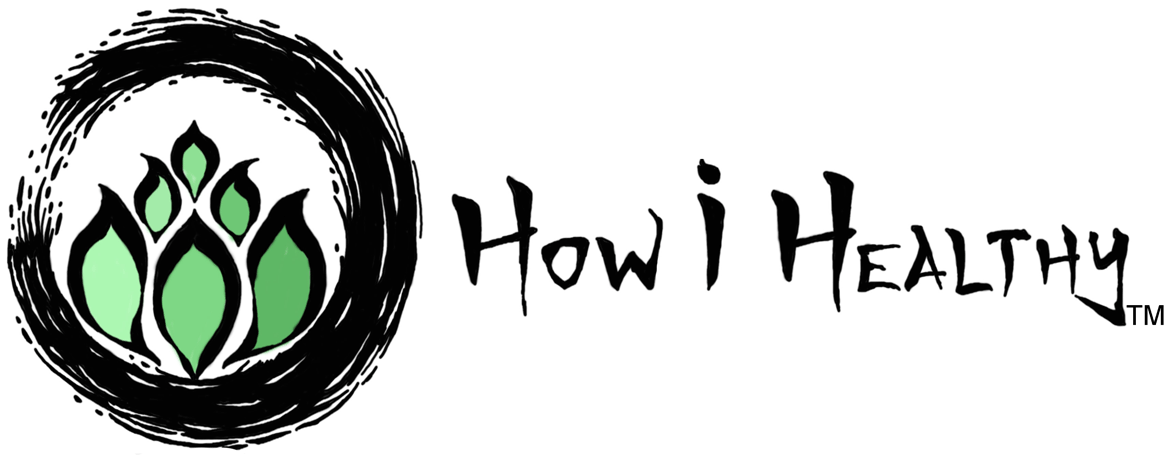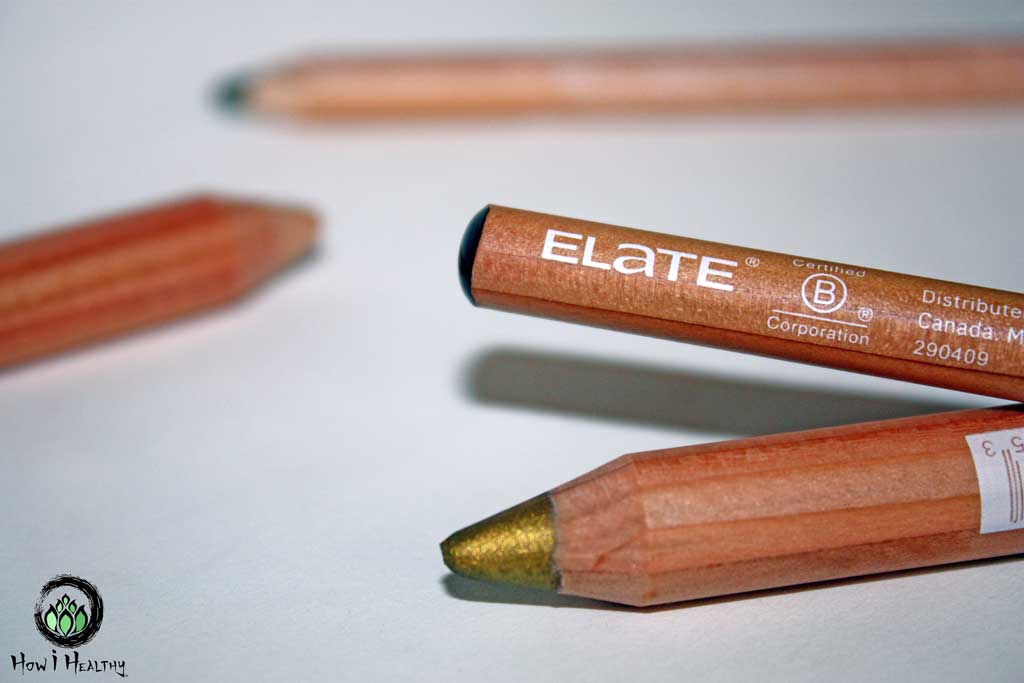In This Article, We'll Cover:
- A Brief History of Toxic Cosmetics
- Problems With Today’s Cosmetics
- How i Healthy’s Favorite Low Waste & Natural Makeup
- Other Skincare Concerns to Keep in Mind
Lead, arsenic, cadmium, heavy metals, carcinogens, endocrine disruptors, and yes, even rat poo contaminate cosmetics. (2, 3, 4, 5, 23, 24, 33, 34, 35, 38, 51, 58, 59)
And it’s legal.
Cosmetics in America have nearly non-existent oversight or regulation. The FDA only bans 11 chemicals from cosmetic formulas. (33)
The European Union and 40 other countries ban over a thousand. Yep, some American cosmetics are illegal in other countries because they are unsafe. (23, 24, 34, 35, 38)
Cosmetics also perpetuate some of the worse plastic waste, child labor abuses, greenwashing claims, and counterfeit markets. (6, 36, 47, 48, 49, 60)
Let’s go back and see how far (or not) cosmetics have come, and what we can do about its future.
History of Toxic Cosmetics
First, etymology! Because words are cool.
Etymology:
French: cosmétique, from Greek: kosmētikos, kosmein, and kosmos meaning “arrange” or “adorn”.
(64)
Cosmetics have a long history. And even from the start, cosmetics contained harmful ingredients.
- Ancient Egyptians used lead chlorides (laurionite and phosgenite) as eyeliner. This protected the wearer from infection, disease, and illness. We now know these lead chlorides can indeed stimulate the immune system. This might have protected against disease as the ancient Egyptian intended. That said, many ancient Egyptians had a life span of only a few decades. So, they may not have experienced the long-term health impacts of their lead exposure. (41, 42)
- Ancient Rome and Greece, then later China, England, and Japan used versions of ceruse. Ceruse is a face mask made of lead, water, and vinegar. The mixture was caustic when applied over the face like paint. It smoothed and whitened the skin, creating a highly desirable pale completion. Although prolong use led to hair loss, skin damage, facial paralysis, premature aging, skin discoloration, and rotten teeth. The longer a person used ceruse, the more they needed to hide the damage it caused. (43)
- Even after ceruse popularity declined, enamels and white paint (still lead-based) were popular. Some affluent women painted their entire bodies with it and used indigo dye over the enamel to create veins. The effect? A translucent, corpse-like completion that was prized and admired. Another effect? Lead poisoning, and all the skin damage health problems it brings. (42, 43)
- “Safe Arsenic Completion Wafers” are just as bad as they sound. Edible arsenic. Sure, the arsenic created a “transparent” completion. But that’s because prolonged use caused vitiligo, or damaged skin pigment cells. Arsenic baths and cosmetics were popular even through the 1800s, long after people knew arsenic was dangerous. (42, 43)
- An 1874 Harper’s Bazaar column titled “The Ugly-girl Papers, Or, Hints for the Toilet” recommended opium night masks, ammonia face & hair wash, and mercury eyelash treatments. And to create that doe-eyed glassy look? Try belladonna (poisonous nightshade) in the eyes. Bonus? It might cause blindness too! (44)
- For centuries, red rouge and lipsticks around the world contained many plant-based dyes, but some also contained red lead or cinnabar (mercury sulfide). (45)
- “Freckle remover recipes” found in ladies’ magazines featured ammonium, arsenic, and mercury compounds too. (45)
It might seem that we are beyond lead-paint and mercury cosmetics, and in some ways, we are. But many cosmetics today still cause harm. And still contain lead. And arsenic. And so much more.
Problems with Today’s Cosmetics
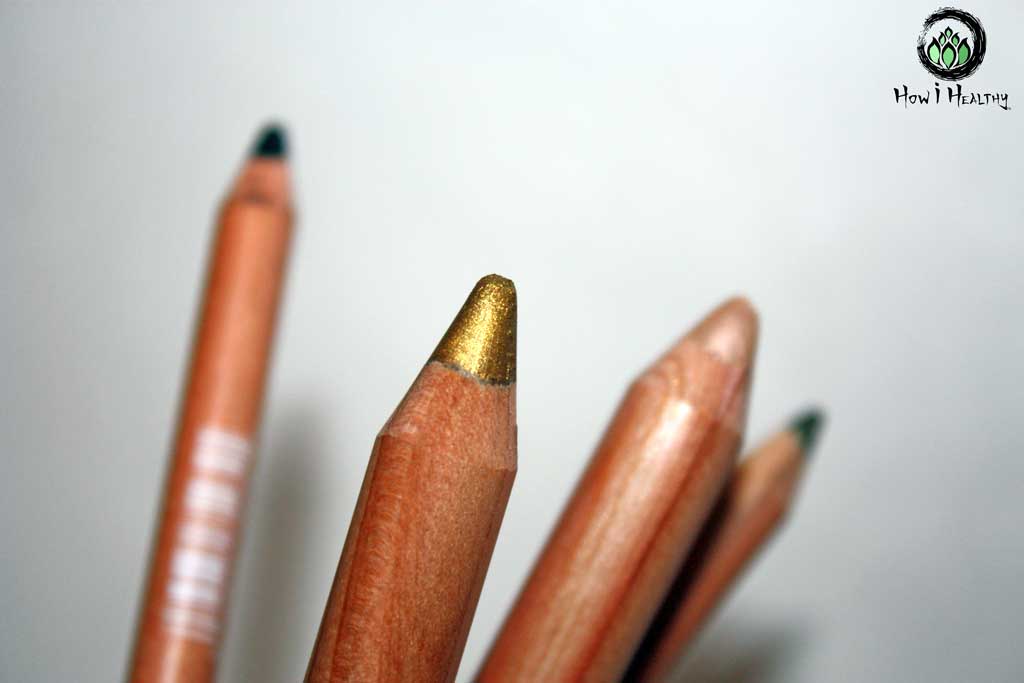
Cosmetics in America have nearly non-existent oversight or regulation. From the thousands of chemicals/ingredients used to make cosmetics, the FDA only bans 11. (33)
Many chemicals found in American cosmetics are banned in the European Union. And in 40 other countries. (23, 24, 34, 35, 38)
Not only can makeup be absorbed through the skin, it is often applied to lips and near the eyes too. That means these chemicals easily enter the body through the mucus membranes.
Cosmetics have more than chemicals going against them though. Let’s explore them all.
Carcinogens, Parabens, & Phthalates
Cosmetics in America legally can contain:
- Carcinogens: Formaldehyde, Coal Tar, Arsenic, and Cadmium. (11, 51)
- Parabens: In a 2019 study, makeup users had 20% higher levels of parabens detected in urine than non-makeup users. Parabens link to hormonal imbalance and endocrine disruption. Meaning decreased fertility, birth defects, breast cancer, and prostate cancer. (20, 21, 22)
- Phthalates: Link to endocrine disruption, reproductive toxicity, and cancer. (12, 38, 50)
Heavy Metals
Cosmetics have shown toxic levels of lead after just a few applications. That’s because eye makeup or lipsticks can contain lead, and that lead enters the body via the mucus membranes. (2, 3, 4, 5, 51)
Lead poisoning can cause developmental delays, learning disabilities, lower IQ, body pain, weakness, dementia, delirium, premature birth, and low birth weight. (25, 26, 27, 28, 29, 30, 31)
(Lead contamination is so prevalent, I wrote a whole How to Avoid Lead guide).
PFAS
Cosmetics have perfluorinated chemicals or “Forever Chemicals”. The impact of these PFAS on our skin is poorly understood. Much of PFAS research focuses on ingested PFAS, PFAS in textiles, and PFAS contaminating the environment. (58, 59)
Little research has investigated the dermal impacts of topically applied PFAS. (58, 59)
PFAS link to DNA fragmentation, endocrine disruption, reduced fecundity, infertility, kidney disorders, thyroid & hormone disruption, and metabolic dysfunction. (52, 53, 54, 55, 56, 57)
Several studies have noted the PFAs might link to several types of cancer. (52, 53, 54, 55, 56, 57)
Again, how topically applied PFAS impact the body are not well documented. We don’t really know how safe or unsafe PFAS on our skin are. (58, 59)
Child Labor: Mica
Mica is a common ingredient in cosmetics, it makes things shiny. Mica is a mineral mined from the ground and links to some of the worse child labor abuses. (48)
India and Madagascar are the largest exporters of mica. The mica is often extracted from illegal mines using child labor. (47, 48)
Many of these children have no safety equipment, gloves, or masks. This leads to development of respiratory problems and pneumonia from mica dust exposure, and skin infections due to cuts from mining with their bare hands. (47, 48)
Most mica mines use narrow shafts prone to collapsing, and children often work in complete darkness. Children have died from lack of oxygen while mining underground. (47, 48)
Children at these mica mines are also more vulnerable to sexual exploitation and human trafficking. (49)
Counterfeits
20 out of 47 products sold through third-party marketplaces were counterfeits, according to a 2018 report by the U.S. Government Accountability Office (GAO). This report products bought on included Amazon®.com, Walmart.com, SearsMarketplace.com, Newegg.com, and Ebay.com. (1)
In that report, 13 Urban Decay® makeup products were tested. 13 out of 13 were counterfeits. (6)
In that same report, the cosmetics tested also contained cyanide, mercury, and rat feces. (1)
Worried about counterfeits? Totally understand. They are everywhere and hard to avoid. Check out the Counterfeit Guide and learn to spot the fakes.
Greenwashing
Oh greenwashing. I wrote a whole Greenwashing Guide and even a Greenwashing in the Sex Toy Industry Guide because I loathe it so much.
Here’s the recap:
“Greenwashing” means advertising a product as more environmentally conscious then it actually is. (9, 10)
Why would a company do that?
Because “eco-friendly” = $$$. Big money.
And natural makeup means really big money.
66% of consumers are willing to pay top dollar for sustainable & ethical products. And corporations exploit that. (10)
Cosmetic buzzwords like “non-toxic”, “all-natural makeup” are not regulated designations by the FDA. They mean nothing. (36)
Even “hypoallergenic cosmetics” is a meaningless phrase. The FDA has no standard, definition, requirements, or certification process for products to claim “hypoallergenic” formulas. (37)
Gender Exclusivity
Most makeup is marketed “for woman”.
Ug, I can’t even write that without feeling awful.
Unfortunately, it’s the truth. Most cosmetic ads, campaigns, and photos feature female-identifying models marketing for female-identifying people.
But cosmetics are for everybody. You do you.
Plastic Waste
Cosmetics are notoriously packaged in plastic.
And those caps, tubes, containers, applicators, bottles, and pallets are hard, if not impossible, to recycle. (60)
Plastic cosmetic waste often ends up in landfills. polluting the environment. (60)
Even natural makeup, or brands claiming to be, are littered with plastic packaing.
My Favorite Ethical, Sustainable, & Natural Makeup
So with all that stacked against cosmetics, what natural makeup brand makes the cut?
A few! And I’ll share my favorite just below. But first, what standard guides my choices?

The How i Healthy Standard
Our favorite products/brands meet as many of these conditions as possible.
Healthy body, healthy planet, & healthy sex means:
- Align with My Best Sustainability & Ethical Tips
- As Local as Possible
- Cruelty-Free
- Doesn’t Contain these Harmful Chemicals
- Environmental and/or Socially Responsible Company
- Ethically Made: Fair Trade, Living Wages, Safe Worker Conditions
- Gender-inclusive
- No Greenwashing Scams
- Organic & Sustainably Harvested Ingredients
- Pass How i Healthy’s Counterfeit Vetting Process
- Purchased Through/From an Ethical Shop/Marketplace.
- Zero Waste / Plastic & Bioplastic-free / Home Compostable
- 1% for the Planet®, B Corporation®, Green American Business®, or similar credentials
The natural makeup market and green cosmetics business is booming. There are many options out there now, my favorite though?
Elate® Beauty
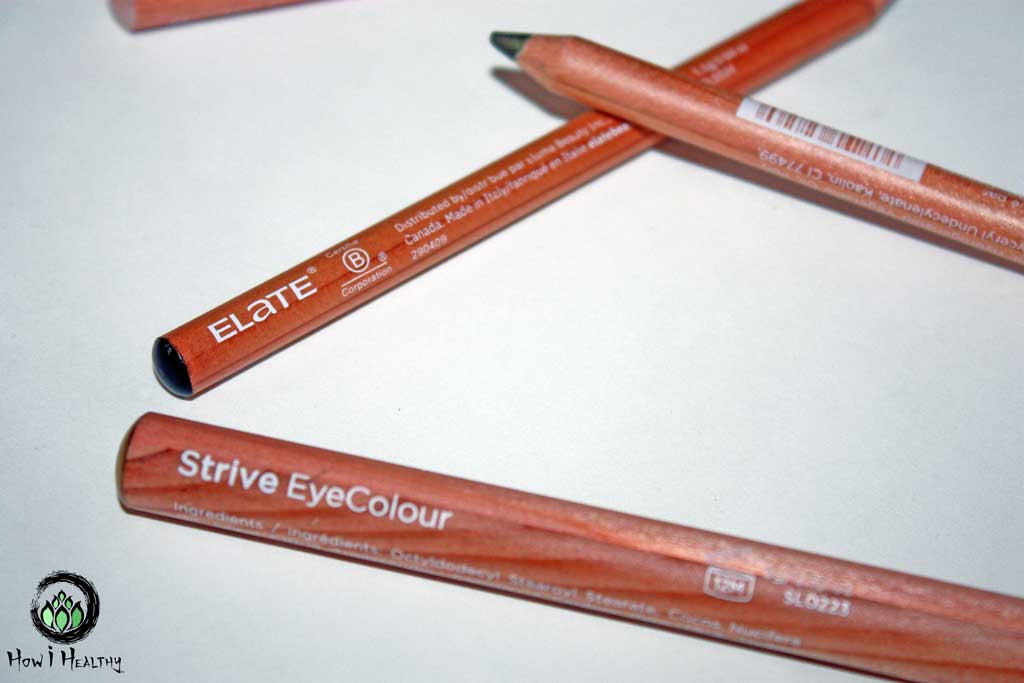

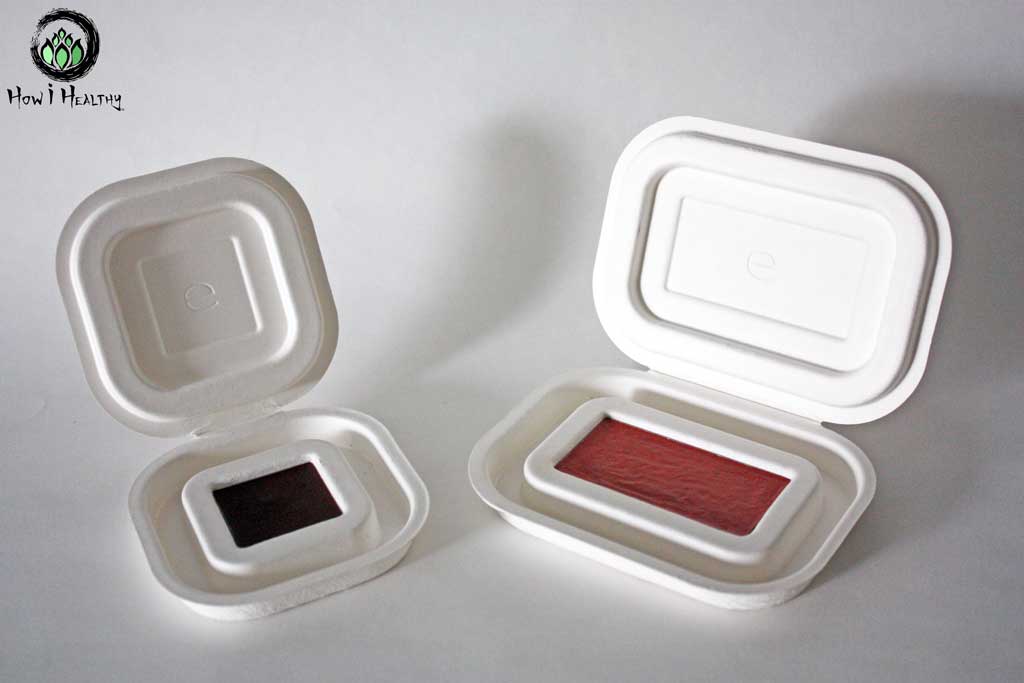
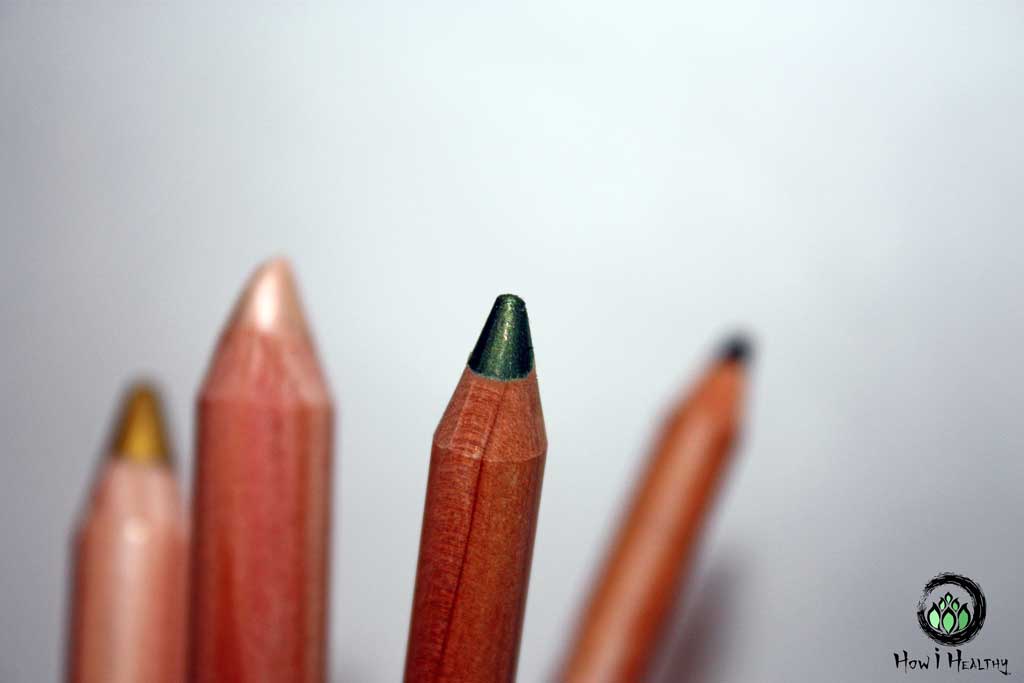
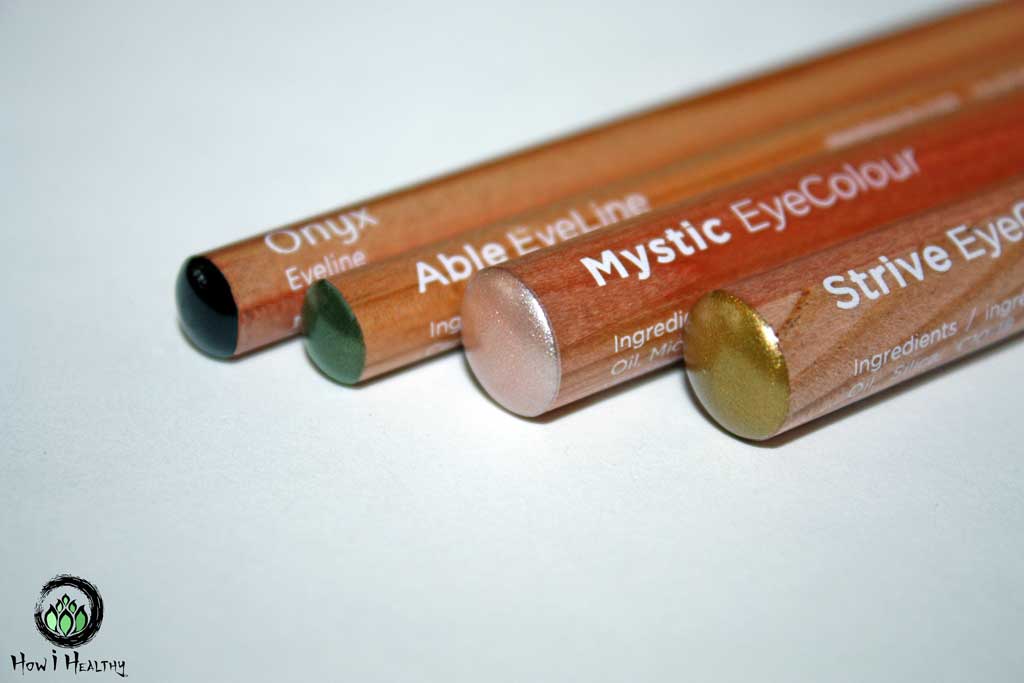
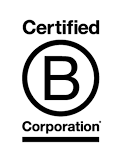
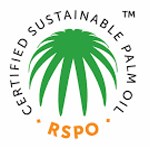
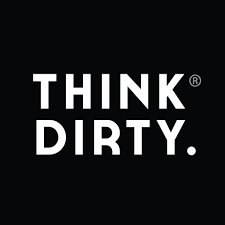
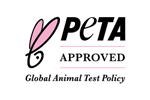
Product Kudos
Origin: Canada & Italy.
End of Life: Compost sugarcane containers. Bio-plastic industrial compost only caps. Elate has a Recycling program for the all hard to recycle parts.
Ingredients/Packaging:
- Elate® Collection: All natural makeup is 100% vegan, cruelty-free, & uses Fair-Trade mica.
- Sustainably harvested Californian cedar wood for eye color pencils.
- All products are free from nano-sized particles (like titanium dioxide).
- No palm oil except for Stearic Acid, which is from a RSPO-Certified sustainable palm oil supplier.
- All bamboo is FSC certified (Forest Stewardship Council), water-processed, and never chemically treated.
- Plastic-free packaging. Pressed products are in compostable sugarcane containers or plantable seed paper.
- Think Dirty® and EWG Verified® low-risk ingredients.
Why It’s Awesome
- Absolutely stunning pigments. I use the EyeColour Pencil in Merit (copper rose) and Strive (gold) as eyeliner, and it is gorgeous!
- No irritation. These products are clean. For me there’s no itching, burning, or irritation. Great for my sensitive skin.
- The Blush Balm is luxurious. I like Bliss (peach). It’s creamy and comes in colors ranging from natural flush to bolder pops of color for all skin tones. My photo does not do this gorgeous color justice.
- The Brow Balm is essential for me. I have patchy, yet long, blond/brown eyebrows (seriously, I trim them with scissors every week). The Auburn Brow Balm adds red undertones, so my eyebrows match my Henna Red Hair. The wax in the balm keeps everything in place.
- The Eyeliner Pencils are creamy and glide on easily while also maintaining staying power. I adore the Able (forest green).
- Simply clean, beautiful, & low-waste makeup. It’s magic.
- Versatile products. Many products are multi-purpose. Blush balm doubles as lip tint, EyeColour Pencil is liner, shadow, or highlighter. So many uses!
Company Kudos
- Beautiful colors. Long-lasting. Ethically made and sourced. Elate® cosmetics is proving it can be done.
- Certified B Corp & PETA® approved.
- Donates 2% of profits to social & environmental initiatives. ($27K and counting!).
- Gender identity-inclusive, age-inclusive, race-inclusive, & body-inclusive for product descriptions & models. Elate says it best, “Whatever your gender identity, age, ethnicity or body type, beauty is for you.”.
- Offers a Professional Artist discount for individuals and businesses.
- Offers a free recycling program for any hard to recycle components.
- PFAS-free cosmetics with low-risk Think Dirty® and EWG Verified® ingredients.
- Plants 1 tree for every order (22,000 trees and counting).
- Woman-owned.
(1, 47)
Other Concerns
Skincare
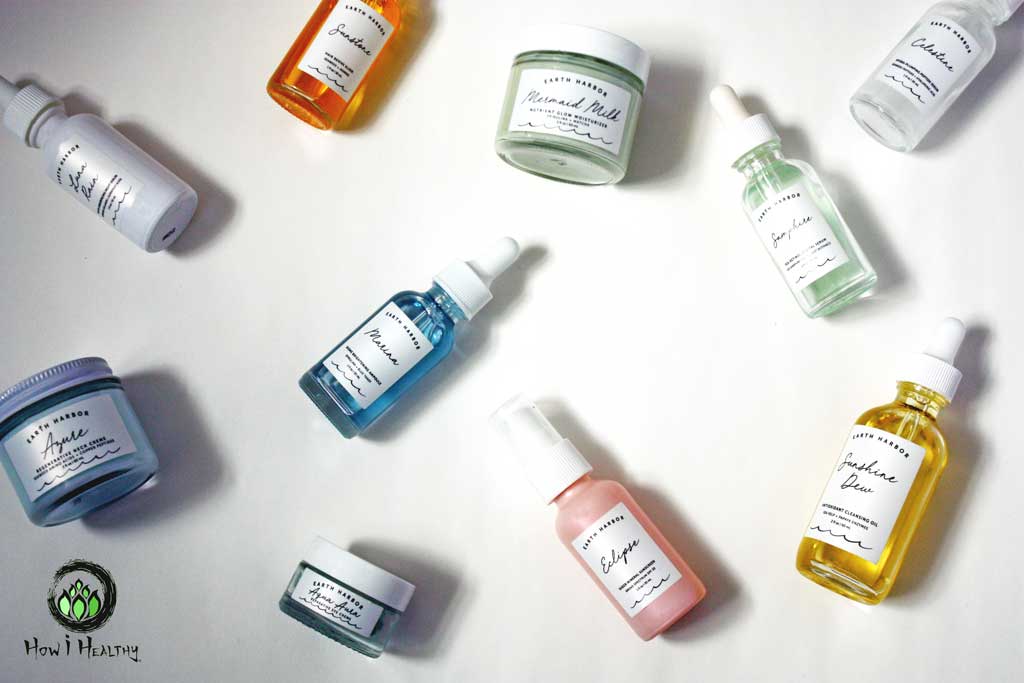
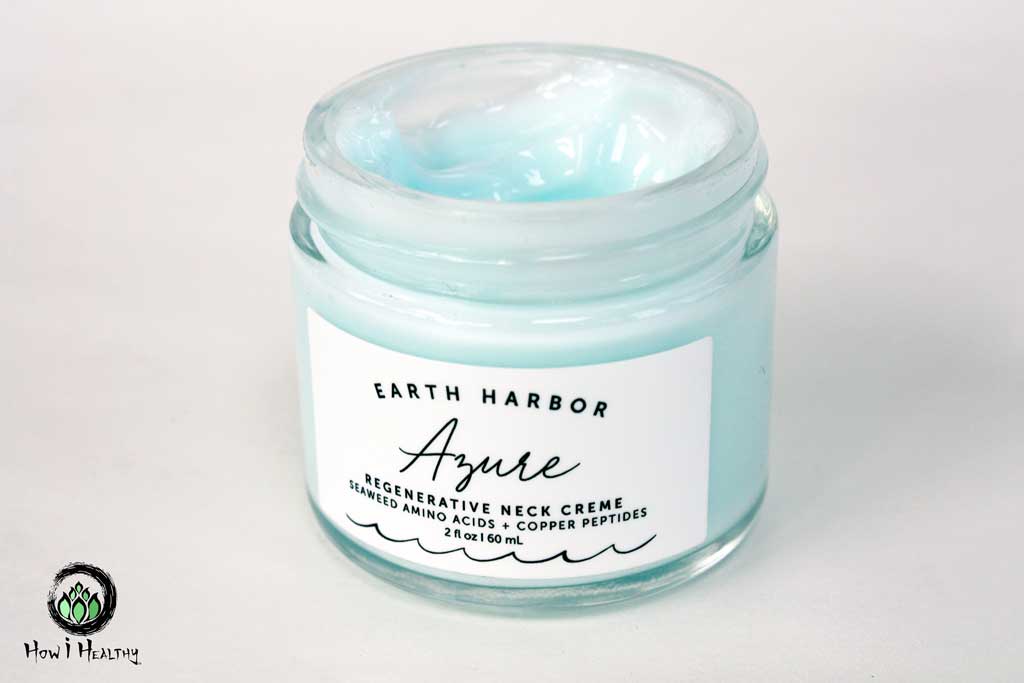
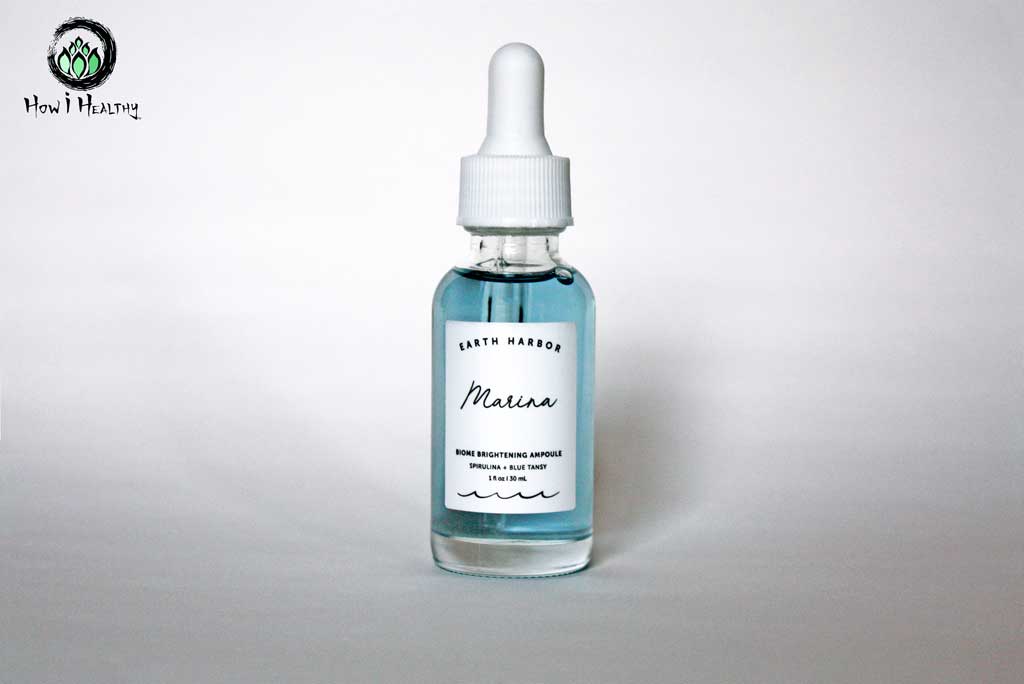
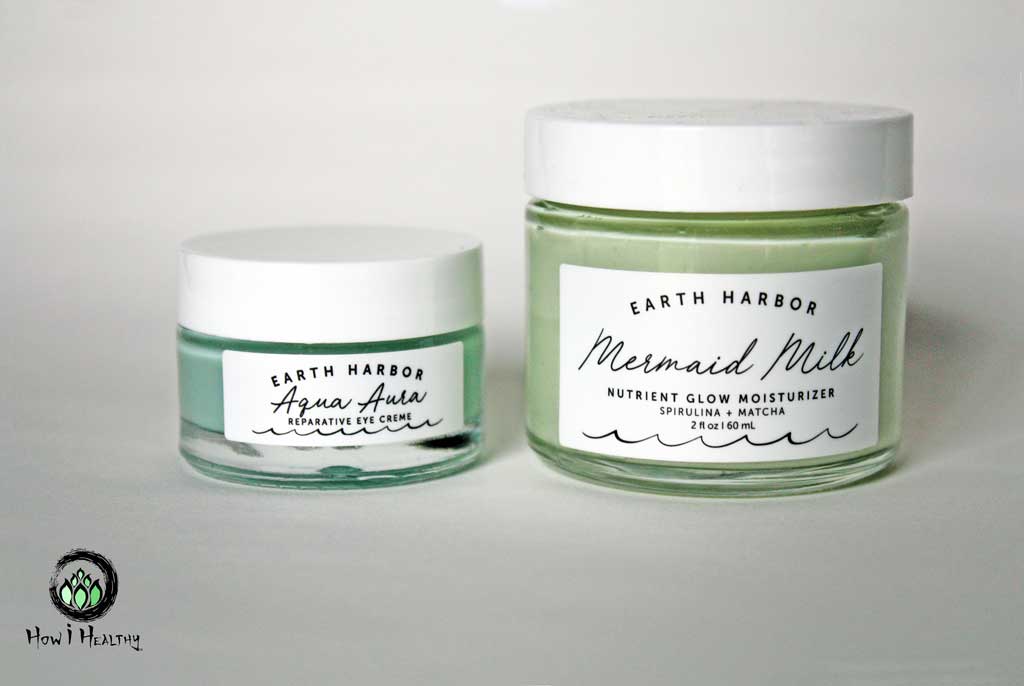
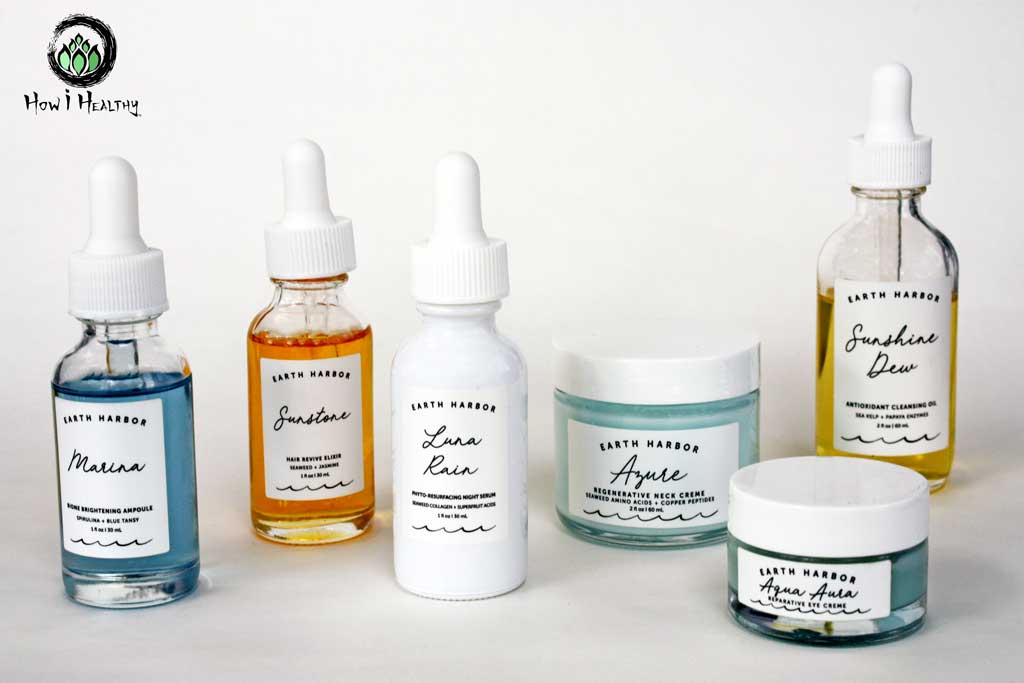
Since we’re talking about natural makeup and better products for our face, let’s add skincare to the conversation.
Moisturizers, treatments, creams, and serums have many of the same problems as cosmetics.
Problems like: greenwashing, questionable ingredients, and plastic packaging.
Bonus? Pseudo-science in skincare is rampant too. That leads to false promises and money pits.
So, want evidence-based, natural skincare in minimal plastic that’s better for people & planet?
Enter: Earth Harbor!
Science-backed natural skincare using sustainable ingredients. And with the third-party certifications (so many!) backing up the claim. Their water-free products contain only active ingredients, no fillers, and have excellent supply chain transparency.
I adore Earth Harbor. Just check out the full Earth Harbor Review, I review the entire collection and all the science behind why it works.
The Takeaway Message
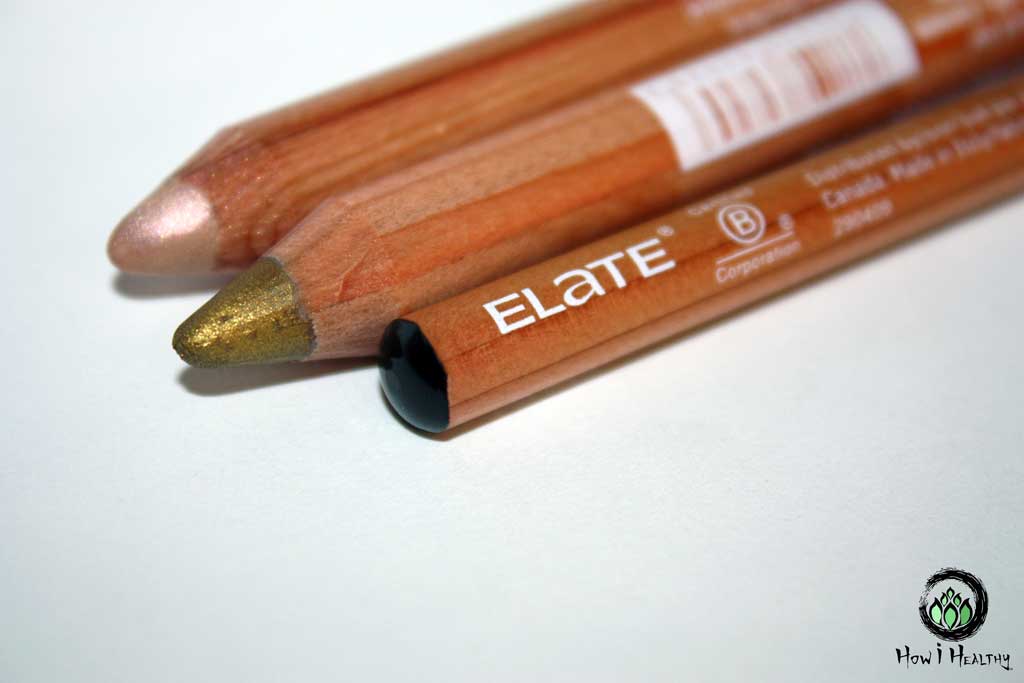
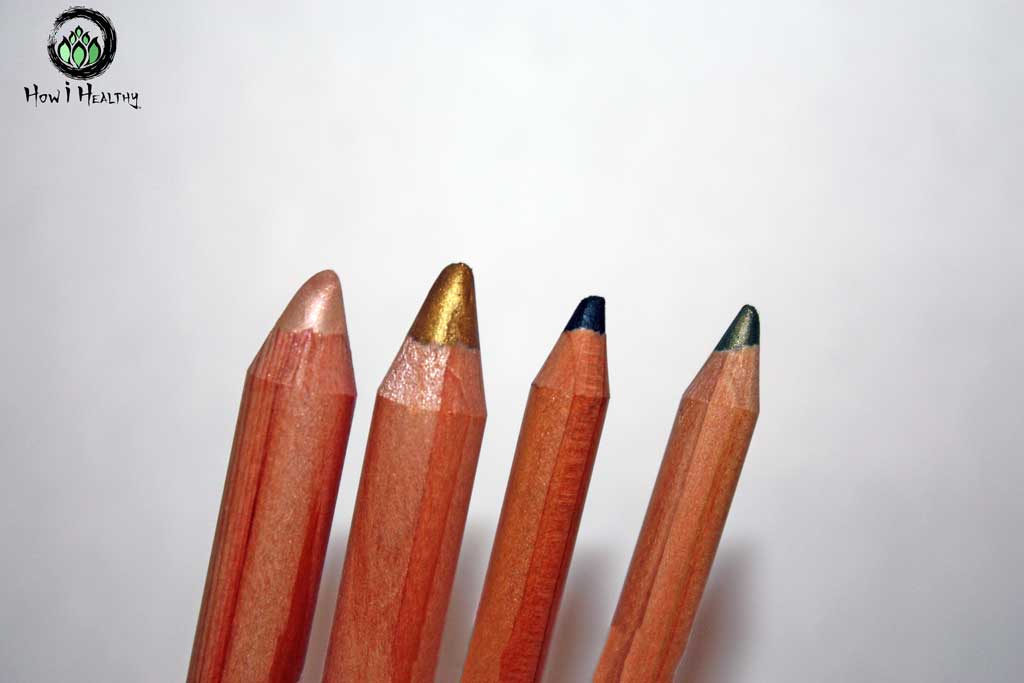
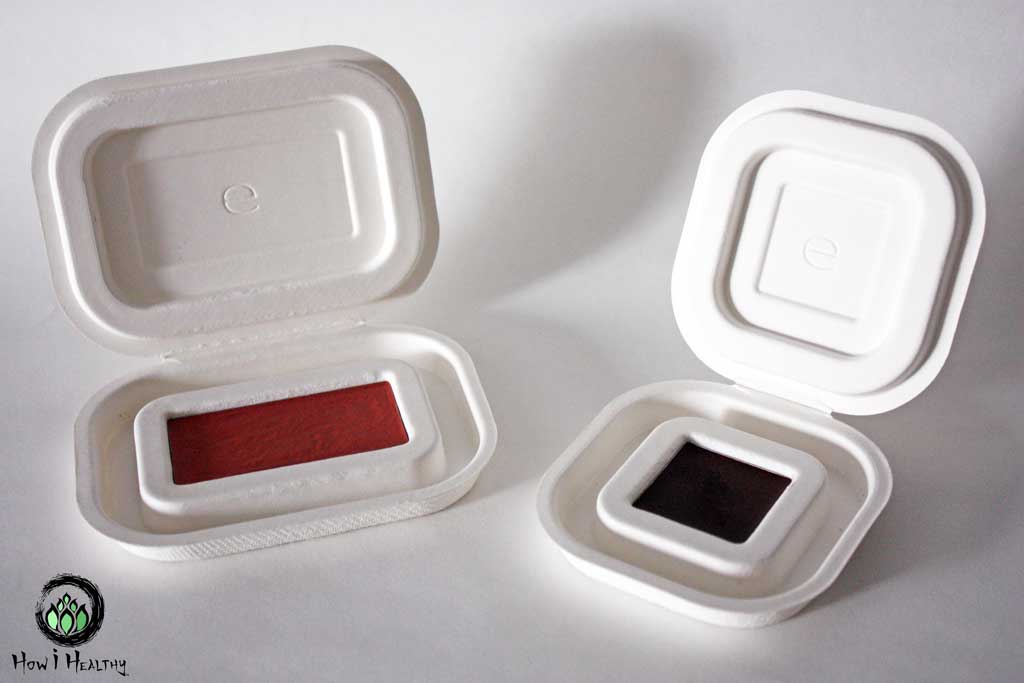
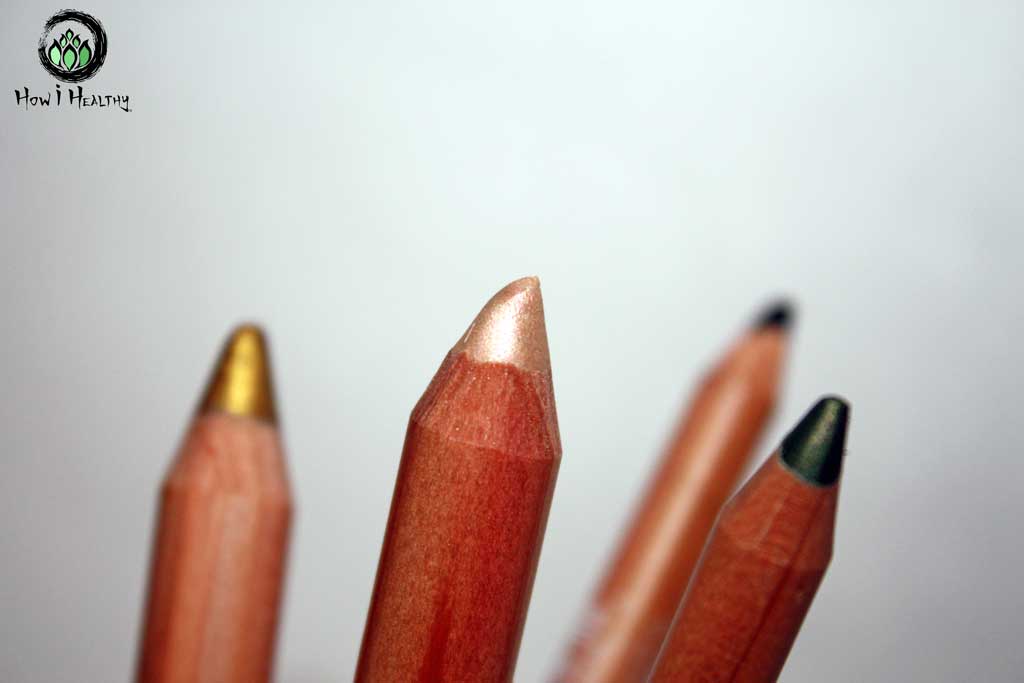
Cosmetics haven’t improved much from lead-based foundations, arsenic complexion biscuits, and mercury eyelash treatments. (42, 43, 44, 45)
That’s because today’s American cosmetics are barely regulated and can legally contain known carcinogens, PFAS, hormone disrupters, and heavy metals in their formulas. (2, 3, 4, 5, 23, 24, 33, 34, 35, 38, 51, 58, 59)
Plus, there’s greenwashing, plastic packaging, child labor, and counterfeit cosmetics. (6, 36, 47, 48, 49, 60)
Even the phrase “hypoallergenic formula” is an unregulated buzzword that requires to evidence to back up the claim. (37)
Finding ethically-made, sustainability-sourced, low waste, & natural makeup is difficult.
Elate® Beauty makes it easy.
- Certified B Corp & PETA® approved.
- Donates 2% of profits to social & environmental initiatives. ($27K and counting!)
- Gender inclusive descriptions and photos.
- PFAS-free cosmetics, Fair-Trade mica, and low-risk Think Dirty® and EWG Verified®
- Uses sustainably harvested cedar wood, FSC certified & water-processed bamboo, RSPO-certifed sustainable plam oil.
- Plastic-free packaging. Pressed products are in compostable sugarcane containers or plantable seed paper. Bioplastic caps are industrial compost only. (hopefully someday it will be home compostable!)
My favorite thing to pair Elate® natural makeup with?
The Earth Harbor Skincare Collection! Sustainably-sourced Evidenced-based natural skin care.
Seriously, I adore them, just see the full Earth Harbor Review and find the best skincare routine for you.
That’s How i Healthy!
-Artemis
- “About Us.” Elate Beauty, https://elatebeauty.com/pages/about-us.
- Monnot, Andrew D et al. “An exposure and health risk assessment of lead (Pb) in lipstick.” Food and chemical toxicology : an international journal published for the British Industrial Biological Research Association 80 (2015): 253-260. doi:10.1016/j.fct.2015.03.022. https://pubmed.ncbi.nlm.nih.gov/25839902/
- Al-Saleh, Iman et al. “Assessment of lead in cosmetic products.” Regulatory toxicology and pharmacology : RTP 54,2 (2009): 105-13. doi:10.1016/j.yrtph.2009.02.005. https://pubmed.ncbi.nlm.nih.gov/19250956/
- Nourmoradi, H et al. “Assessment of lead and cadmium levels in frequently used cosmetic products in Iran.” Journal of environmental and public health 2013 (2013): 962727. doi:10.1155/2013/962727. https://pubmed.ncbi.nlm.nih.gov/24174937/
- Kaličanin, Biljana, and Dragan Velimirović. “A Study of the Possible Harmful Effects of Cosmetic Beauty Products on Human Health.” Biological trace element research 170,2 (2016): 476-84. doi:10.1007/s12011-015-0477-2. https://pubmed.ncbi.nlm.nih.gov/26296330/
- GAO, United States Government Accountability Office. “INTELLECTUAL PROPERTY.” Agencies Can Improve Efforts to Address Risks Posed by Changing Counterfeits Market, Report to the Chairman, Committee on Finance, U.S. Senate, Jan. 2018, https://www.gao.gov/assets/gao-18-216.pdf
- Combating Trafficking in Counterfeit and Pirated Goods .” Office of Strategy, Policy & Plans, U.S. Department of Homeland Security, 24 Jan. 2020, dhs.gov/sites/default/files/publications/20_0124_plcy_counterfeit-pirated-goods-report_01.pdf
- OECD/EUIPO (2016), Trade in Counterfeit and Pirated Goods: Mapping the Economic Impact, Illicit Trade, OECD Publishing, Paris, https://doi.org/10.1787/9789264252653-en. https://www.oecd-ilibrary.org/governance/trade-in-counterfeit-and-pirated-goods_9789264252653-en
- “Greenwashing.” Merriam-Webster, Merriam-Webster, 2020, merriam-webster.com/dictionary/greenwashing
- de Freitas Netto, S.V., Sobral, M.F.F., Ribeiro, A.R.B. et al.Concepts and forms of greenwashing: a systematic review. Environ Sci Eur32, 19 (2020). https://doi.org/10.1186/s12302-020-0300-3. https://enveurope.springeropen.com/articles/10.1186/s12302-020-0300-3
- “Toxic Chemicals Found in Cosmetics.” American Testing Lab Inc., www.american-testing.com/uncategorized/toxic-chemicals-found-in-cosmetics/.
- Center for Food Safety and Applied Nutrition. “Fragrances in Cosmetics.” Food and Drug Administration, FDA, 2020, www.fda.gov/cosmetics/cosmetic-ingredients/fragrances-cosmetics#labeling
- Center for Food Safety and Applied Nutrition. “1,4-Dioxane in Cosmetics.” Food and Drug Administration, FDA, 2020, www.fda.gov/cosmetics/potential-contaminants-cosmetics/14-dioxane-cosmetics-manufacturing-byproduct
- European Commission – PRESS RELEASES – Press Release – Consumers: Commission Improves Safety of Cosmetics, https://ec.europa.eu/commission/presscorner/detail/en/IP_14_1051
- Jang, Hyun-Jun, et al. “Safety Evaluation of Polyethylene Glycol (PEG) Compounds for Cosmetic Use.” Toxicological Research, The Korean Society Of Toxicology, June 2015, nlm.nih.gov/pmc/articles/PMC4505343/
- Johnson, W Jr, and Cosmetic Ingredient Review Expert Panel. “Final report on the safety assessment of PEG-25 propylene glycol stearate, PEG-75 propylene glycol stearate, PEG-120 propylene glycol stearate, PEG-10 propylene glycol, PEG-8 propylene glycol cocoate, and PEG-55 propylene glycol oleate.” International journal of toxicology20 Suppl 4 (2001): 13-26. doi:10.1080/10915810152902556. https://pubmed.ncbi.nlm.nih.gov/11800049/
- Black, R E et al. “Occurrence of 1,4-dioxane in cosmetic raw materials and finished cosmetic products.” Journal of AOAC International84,3 (2001): 666-70.
- Scalia S, Menegatti E. Assay of 1,4-dioxane in commercial cosmetic products by HPLC. Farmaco (Societa Chimica Italiana : 1989). 1991 Nov;46(11):1365-1370
- Johnson, Wilbur Jr et al. “Safety Assessment of Dimethiconol and Its Esters and Reaction Products as Used in Cosmetics.” International journal of toxicology36,3_suppl (2017): 31S-50S. doi:10.1177/1091581817739429. https://pubmed.ncbi.nlm.nih.gov/29243542/
- Berger, Kimberly P, et al. “Personal Care Product Use as a Predictor of Urinary Concentrations of Certain Phthalates, Parabens, and Phenols in the HERMOSA Study.” Journal of Exposure Science & Environmental Epidemiology, U.S. National Library of Medicine, Jan. 2019, nlm.nih.gov/pubmed/29317738
- Engeli, Roger T, et al. “Interference of Paraben Compounds with Estrogen Metabolism by Inhibition of 17β-Hydroxysteroid Dehydrogenases.” International Journal of Molecular Sciences, MDPI, 19 Sept. 2017, nlm.nih.gov/pmc/articles/PMC5618656/
- Darbre, Philippa D, and Philip W Harvey. “Paraben Esters: Review of Recent Studies of Endocrine Toxicity, Absorption, Esterase and Human Exposure, and Discussion of Potential Human Health Risks.” Journal of Applied Toxicology : JAT, U.S. National Library of Medicine, July 2008, nlm.nih.gov/pubmed/18484575/
- European Commission – PRESS RELEASES – Press Release – Consumers: Commission Improves Safety of Cosmetics, https://ec.europa.eu/commission/presscorner/detail/en/IP_14_1051
- “Overview Report I: Worldwide Initiatives to Identify Endocrine Disrupting Chemicals (EDCs) and Potential EDCs.” The International Panel on Chemical Pollution (IPCP), 2017, https://wedocs.unep.org/bitstream/handle/20.500.11822/25633/EDC_report1.pdf?sequence=1&isAllowed
- “Lead Poisoning and Health.” World Health Organization, 2019, who.int/en/news-room/fact-sheets/detail/lead-poisoning-and-health
- Needleman, Herbert. “Lead Poisoning.” Annual Review of Medicine Vol. 55:209-222 (Volume Publication Date 18 February 2004), University of Pittsburgh School of Medicine, 2003, annualreviews.org/doi/10.1146/annurev.med.55.091902.103653#_i6
- Wani, Ab Latif et al. “Lead toxicity: a review.” Interdisciplinary toxicology 8,2 (2015): 55-64. doi:10.1515/intox-2015-0009. https://pubmed.ncbi.nlm.nih.gov/27486361/
- Bent, S., Göttsch, C., Braam, U. et al. The effects of heavy metal ions (Cd2+, Hg2+, Pb2+, Bi3+) on histamine release from human adenoidal and cutaneous mast cells. Agents and Actions 36, C321–C324 (1992). https://doi.org/10.1007/BF01997363. https://link.springer.com/article/10.1007/BF01997363
- Metryka, Emilia et al. “Lead (Pb) Exposure Enhances Expression of Factors Associated with Inflammation.” International journal of molecular sciences 19,6 1813. 20 Jun. 2018, doi:10.3390/ijms19061813. https://pubmed.ncbi.nlm.nih.gov/29925772/
- Doh HW, Stebbins CL, Choi HM, Park J, Nho H, Kim JK. Histamine H2 receptor blockade augments blood pressure responses to acute submaximal exercise in males. Appl Physiol Nutr Metab. 2016;41(6):605–610. doi:10.1139/apnm-2015-0450. https://pubmed.ncbi.nlm.nih.gov/27191340/
- Liévanos, Raoul S., et al. “An Intercategorical Ecology of Lead Exposure: Complex Environmental Health Vulnerabilities in the Flint Water Crisis.” International Journal of Environmental Research and Public Health, vol. 18, no. 5, 2021, p. 2217., https://doi.org/10.3390/ijerph18052217. https://www.mdpi.com/1660-4601/18/5/2217
- “The Toxic Twelve Chemicals and Contaminants in Cosmetics.” Environmental Working Group, ewg.org/the-toxic-twelve-chemicals-and-contaminants-in-cosmetics
- Center for Food Safety and Applied Nutrition. “Prohibited & Restricted Ingredients in Cosmetics.” S. Food and Drug Administration, FDA, www.fda.gov/cosmetics/cosmetics-laws-regulations/prohibited-restricted-ingredients-cosmetics
- “Cosmetic Products Regulation, Annex III – Restricted Substances.” ECHA, 2024, echa.europa.eu/cosmetics-restricted-substances.
- Alyssa Katzenelson & Scott Faber, On Cosmetics Safety, U.S. Trails More Than 40 Nations, Envtl. Working Grp. (Mar. 20, 2019), https://www.ewg.org/news-insights/news/2021/08/protecting-consumers-toxics-cosmetics-us-lags-least-80-countries.
- Medley, Eleanor A et al. “Usage of Children’s Makeup and Body Products in the United States and Implications for Childhood Environmental Exposures.” International journal of environmental research and public health 20,3 2114. 24 Jan. 2023, doi:10.3390/ijerph20032114. https://www.ncbi.nlm.nih.gov/pmc/articles/PMC9915933/
- for Food Safety and Applied Nutrition. “‘hypoallergenic’ Cosmetics.” S. Food and Drug Administration, FDA, www.fda.gov/cosmetics/cosmetics-labeling-claims/hypoallergenic-cosmetics.
- Center for Food Safety and Applied Nutrition. “Phthalates in Cosmetics.” S. Food and Drug Administration, FDA, www.fda.gov/cosmetics/cosmetic-ingredients/phthalates-cosmetics.
- Balwierz, Radosław et al. “Potential Carcinogens in Makeup Cosmetics.” International journal of environmental research and public health 20,6 4780. 8 Mar. 2023, doi:10.3390/ijerph20064780. https://www.ncbi.nlm.nih.gov/pmc/articles/PMC10048826/
- Kaličanin, Biljana, and Dragan Velimirović. “A Study of the Possible Harmful Effects of Cosmetic Beauty Products on Human Health.” Biological trace element research 170,2 (2016): 476-84. doi:10.1007/s12011-015-0477-2. https://pubmed.ncbi.nlm.nih.gov/26296330/
- Finding Out Egyptian Gods’ Secret Using Analytical Chemistry: Biomedical Properties of Egyptian Black Makeup Revealed by Amperometry at Single Cells. Issa Tapsoba, Stéphane Arbault, Philippe Walter, and Christian Amatore. Analytical Chemistry2010 82 (2), 457-460. https://pubs.acs.org/doi/full/10.1021/ac902348g
- Little, Becky. “Arsenic Pills and Lead Foundation: The History of Toxic Makeup.” National Geographic, 22 Sept. 2016, www.nationalgeographic.com/science/article/ingredients-lipstick-makeup-cosmetics-science-history.
- Stewart, Susan. Painted Faces: A Colourful History of Cosmetics. Amberley Publishing, 2021.
- POWERS, S. D. Ugly-Girl Papers, or Hints for the Toilet. FORGOTTEN BOOKS, 2018.
- Eldridge, Lisa. Face Paint: The Story of Makeup. Abrams Image, 2015.
- Elate Beauty Twitter Statement. June 23, 2021.
- “Eliminating Child Labor in Mica-Producing Communities and Promoting Responsible Mica Sourcing in Madagascar and Globally (MICA).” S. Department of Labor, Bureau of International Labor Affairs, www.dol.gov/agencies/ilab/eliminating-child-labor-mica-producing-communities-and-promoting-responsible-mica
- Rybarczyk, Katarzyna. “Ending Child Labor in Mica Mines in India and Madagascar.” The Stop Child Labor Coalition, CLC Contributor, 14 July 2021, https://stopchildlabor.org/ending-child-labor-in-mica-mines-in-india-and-madagascar/
- “2019 Findings on the Worst Forms of Child Labor: Madagascar.” Bureau of International Labor Affairs, 2019, www.dol.gov/sites/dolgov/files/ILAB/child_labor_reports/tda2019/Madagascar.pdf.
- “Phthalates.” Campaign for Safe Cosmetics, safecosmetics.org/chemicals/phthalates/
- “Carcinogens in Cosmetics.” Campaign for Safe Cosmetics, safecosmetics.org/chemicals/known-carcinogens/
- Suja, Fatihah, et al. “Contamination, Bioaccumulation and Toxic Effects of Perfluorinated Chemicals (PFCs) in the Water Environment: a Review Paper.” Water Science and Technology : a Journal of the International Association on Water Pollution Research, U.S. National Library of Medicine, 2009, nlm.nih.gov/pubmed/19759456
- Liu, Changhui, et al. “Genotoxicity of Perfluorinated Chemicals (PFCs) to the Green Mussel (Perna Viridis).” The Science of the Total Environment, U.S. National Library of Medicine, 15 July 2014, nlm.nih.gov/pubmed/24784736
- Sonthithai, Pacharapan, et al. “Perfluorinated Chemicals, PFOS and PFOA, Enhance the Estrogenic Effects of 17β-Estradiol in T47D Human Breast Cancer Cells.” Journal of Applied Toxicology : JAT, U.S. National Library of Medicine, June 2016, nlm.nih.gov/pubmed/26234195
- Vélez, M P, et al. “Maternal Exposure to Perfluorinated Chemicals and Reduced Fecundity: the MIREC Study.” Human Reproduction (Oxford, England), Oxford University Press, Mar. 2015, nlm.nih.gov/pubmed/25567616
- Panieri, Emiliano et al. “PFAS Molecules: A Major Concern for the Human Health and the Environment.” Toxics10,2 44. 18 Jan. 2022, doi:10.3390/toxics10020044. https://pubmed.ncbi.nlm.nih.gov/35202231/
- Bonato, Marco et al. “PFAS Environmental Pollution and Antioxidant Responses: An Overview of the Impact on Human Field.” International journal of environmental research and public health17,21 8020. 30 Oct. 2020, doi:10.3390/ijerph17218020. https://www.ncbi.nlm.nih.gov/pmc/articles/PMC7663035/
- Pütz, Kerstin Winkens et al. “Are cosmetics a significant source of PFAS in Europe? product inventories, chemical characterization and emission estimates.” Environmental science. Processes & impacts 24,10 1697-1707. 19 Oct. 2022, doi:10.1039/d2em00123c
- Namazkar, Shahla et al. “Characterization and dermal bioaccessibility of residual- and listed PFAS ingredients in cosmetic products.” Environmental science. Processes & impacts 26,2 259-268. 21 Feb. 2024, doi:10.1039/d3em00461a
- Cubas, Anelise Leal Vieira et al. “Plastics and Microplastic in the Cosmetic Industry: Aggregating Sustainable Actions Aimed at Alignment and Interaction with UN Sustainable Development Goals.” Polymers 14,21 4576. 28 Oct. 2022, doi:10.3390/polym14214576. https://www.ncbi.nlm.nih.gov/pmc/articles/PMC9657586/
- L;, Levy BR;Slade MD;Pietrzak RH;Ferrucci. “Positive Age Beliefs Protect against Dementia Even among Elders with High-Risk Gene.” PloS One, U.S. National Library of Medicine, pubmed.ncbi.nlm.nih.gov/29414991/. Accessed 5 Jan. 2024. https://pubmed.ncbi.nlm.nih.gov/29414991/
- Levy, Becca R, et al. “Ageism Amplifies Cost and Prevalence of Health Conditions.” OUP Academic, Oxford University Press, 13 Nov. 2018, academic.oup.com/gerontologist/article/60/1/174/5166947.
- Levy, Becca. Breaking the Age Code. William Morrow, 2023.
- “Cosmetic (n.).” Etymology, www.etymonline.com/word/cosmetic.
Want More?
And a final, but important note: When we talk about cosmetics, the words we use matter.
The cosmetic industry and skincare industry are full of ageist messaging. And it hurts people. (63)
Ageism is the most socially acceptable for of discrimination. Society perpetuates stereotypes and false narratives about age/aging. This leads to prejudice and discrimination. (63)
Things like: “anti-wrinkle” cream, “look younger” makeup tips, and “anti-aging” treatments are all negative narratives about age/aging in the skincare industry.
Positive views on age/aging can increase our lifespan, decrease the risk of Alzheimer’s (even with a dominate gene present), and reduce health conditions like depression and cardiovascular disease. (63)
Check out this book at your library or buy from your local bookstore:
Breaking the Age Code: How Your Beliefs About Aging Determine How Long and Well You Live
By Dr. Becca Levy
Dr. Levy lays out the data, the science, and the way to change how we think about aging for ourselves and others. Because doing so will help you live longer. And more so than almost anything else you do. (63)
I used to think about (and worry about) wrinkles. Then I read this book and realized I had it all wrong.
This book changed my life. Sound ridiculous? Read it and see for yourself.
This book takes what you might think about age and dismantles it. Dr. Levy calls out ageist culture, the most widely accepted form of discrimination, and offers a positive perspective on aging. A positive perspective, in turns out, makes all the difference.
Simply having a better outlook on age can add years to our lives. Up to 7.5 years to be precise. Dr. Levy, a leader in her field of gerontology, offers study after study explaining why our age beliefs can make or break us. Beyond self-help though, Dr. Levy offers actions to dismantle systemic and structural ageism in our communities too.
Beyond the content, this book readable and enjoyable to read. The style is informative, but not alienating with academic talk. Very down to Earth.
It’s so good, I read it aloud to my partner so we can age together happily and keep each other in check if we slide into ageist thinking.
Buy at: Bookshop® or Better World Books®
